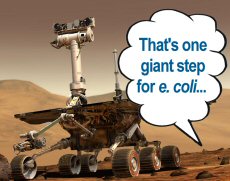2 December 2005
In Space, No One Can Hear You Say "Doh!"
By Carmelo Amalfi
Space exploration is an unpredictable business - no matter how well you plan ahead. Some mistakes cost lives, others cost money, and for some, well, we've yet to know the price we'll have to pay. But hey, it's not a mistake, it's a learning experience!
 Say Cheese!
Say Cheese!
American astronaut Neil Armstrong commits a huge public relations blunder when he forgets to hand the camera to "Buzz" Aldrin during their historic adventure on the Moon. End result? No still photographs of Neil Armstrong, the first guy to set foot on the moon. When LIFE magazine wanted a cover photograph of Armstrong on the moon, they had to use one of Buzz. But as some consolation, Armstrong was reflected in Aldrin's spacesuit visor!
Miles or Kilometers?
NASA's $125m mission to study the climate on Mars was destroyed in 1999 when a navigation error caused the Mars Climate Orbiter to undershoot its target altitude by 90km (54 miles). Rather than entering Mars' atmosphere at its target altitude, it came instead to within 60km of the planet's surface. The spacecraft, traveling at speeds of around 16,000kmh, was consequently torn apart in the atmosphere. The minimum survivable altitude was 85km - Dang! Missed by that much! A review board found the navigation error was caused when some of the spacecraft's commands were sent in imperial units rather than metric.
Rough Landing
NASA appoints a mishap investigation board to find out why parachutes on its Genesis mission didn't deploy properly when the space probe returned to Earth in September 2004. It had been collecting samples of the solar wind which scientists on Earth were eager to study. The board found the likely cause was a design error involving deceleration sensors. These switches sense the braking caused by reentry into the atmosphere, initiating the sequence leading to deployment of the parachutes and parafoil. But because the design plans didn't indicate orientation, the components were installed upside down. As a result, the $264 million mission nose-dived into the Utah desert at 300kmh.
Orbiting White Elephant
Overbudget and still not finished, the International Space Station is an easy target for critics who question the usefulness of the orbiting space laboratory. An estimated $100 billion has been spent on the station when it was supposed to cost $8 billion. Part of the reason was Russia's decision to buy into the station, subsidized for mostly political reasons by the U.S. and NASA.
 Oops, We Terraformed Mars
Oops, We Terraformed Mars
A NASA microbiologist confirms the presence of bacteria in the chambers used to test the Mars landers Spirit and Opportunity, now tracking across the Martian landscape. Contaminating other planets is a UN treaty breach and, according to some scientists, the gaffe may have compromised future missions to find life on Mars.
Disaster Averted
A faulty thermostat triggers an explosion that almost claims the lives of US Apollo 13 astronauts Jim Lovell, Fred Haise and Jack Swigert while on the way to the Moon in 1970. The explosion in turn causes an oxygen tank to explode and blast to pieces parts of the command module, rendering the module virtually useless and forcing the crew to take refuge in the lunar module. Designed to carry two men, the module became a lifeboat for four days until their return to Earth. After the mishap, the Apollo program was held up as a technical triumph in the risky business of space exploration, with no lives lost save the three men who died in the Apollo 1 disaster in 1967.
Mirror, Mirror in Space
The Hubble Space Telescope was launched into orbit in 1990 with a flawed mirror while a back-up mirror sat useless in a warehouse. But in 1993 NASA turned Hubble's spherical aberration into a PR triumph when astronauts installed new components to correct the aberration in the primary mirror of Hubble's 2.4m telescope. Since then, Hubble's images of space have captivated millions of people.
Calling Saturn
NASA engineers realized well into the US-European Cassini-Huygens mission that once the mother ship Cassini had released the European Space Agency Huygens probe in late 2004, the spacecraft could not communicate because engineers had not fully accounted for the Doppler shift in signals from the probe as it fell towards the surface of Saturn's biggest moon Titan. Engineers managed to correct the Doppler shift (by commanding Cassini to release the probe at a higher altitude) so that the Huygens lander came within range of Cassini's receivers. To make matters worse, a software command meant to switch on one of Cassini's receivers was never sent, so Cassini picked up only half the data beamed back by Huygens as it fell into Titan's atmosphere. Luckily, ground based radio telescopes - in a historic global hook-up - managed to pick up the faint signals and salvage the experiment.
A Hyphen, a Hyphen, My Spacecraft for a Hyphen
NASA's Mariner 1 never got to Venus in 1962 because someone omitted a hyphen in the software programming. A post flight review board found the omission in the data-editing program generated incorrect guidance signals for the spacecraft. The omission of the hyphen caused the computer to execute a series of erroneous course corrections that finally threw Mariner 1 off-course. Crash.
Danger on the Ground
In 1964, at a Cape Canaveral assembly unit, a Delta rocket's third-stage motor had just been mated to the Orbiting Solar Observatory spacecraft in preparation for pre-launch tests when suddenly the rocket ignited. The workroom became a furnace of searing rocket exhaust fumes, burning eleven engineers and technicians, three of them fatally. An investigation found static electricity probably ignited the propellant.
Pics courtesy NASA
